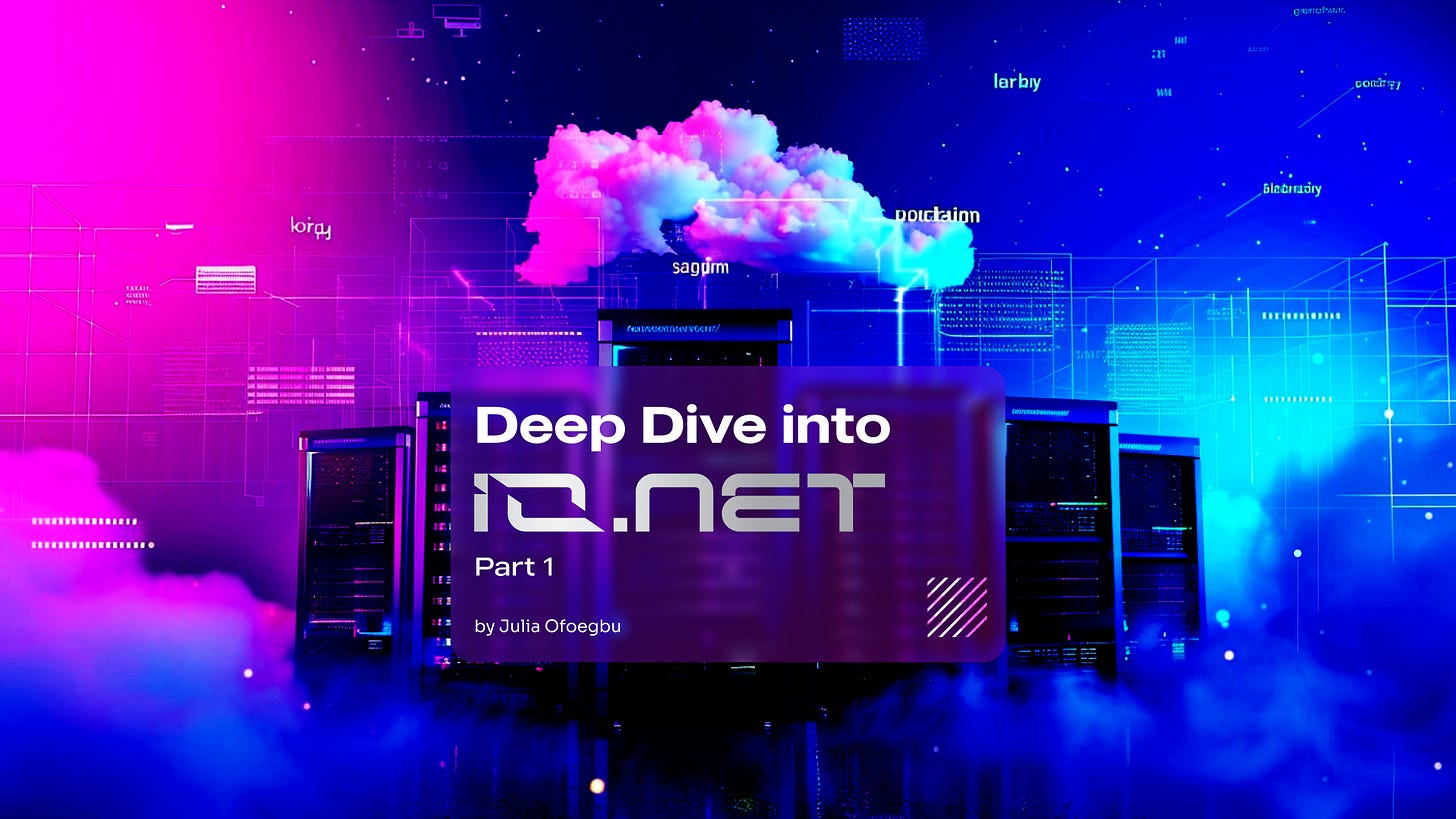A DEEP DIVE INTO IO.NET
An extensive article into io.net - the Internet of GPUs. Looking past the crypto angle, a deep dive into how io.net is utilizing blockchain & DePIN for AI/ML companies.
INTRODUCTION
In 2018, OpenAI published a research report titled “AI and compute”. I promise I just wanted to skim through but alas I found myself down the rabbit hole. In this research paper (which is referenced at the end of this article), a lot was said but a few things stood out.
“Compute is unusually quantifiable, providing an opportunity to measure one input to AI progress.”
“More compute seems to lead predictably to better performance.”
“We believe the relevant number is not the speed of a single GPU, nor the capacity of the biggest data center, but the amount of compute that is used to train a single model.”
Stick with me. It’s gonna be an interesting ride from here on.
AI: ARE THE ALIENS COMING FOR US ALL?
Artificial Intelligence (AI) is the simulation of human intelligence in artificial machines intended to program them with the ability to perform tasks as humans can, even better. AI machines are designed to imitate natural behaviors and cognitive activities. To be able to properly function, AI and machine learning (ML) companies need to train models to enhance performance.
For a blooming and ever-evolving sector like AI, the research paper highlights 3 factors that push its advancement:
Algorithmic innovation: this is the process of applying algorithms to produce ground-breaking, state-of-the-art technologies that provide solutions to actual issues. Think of algorithmic innovation as the brain.
Data: the importance of data in any industry cannot be over-emphasized. Without data being fed into them, AI machines wouldn’t know what to do. Now you get the reason why AI needs human data to be brought alive. Yes, the aliens need us to survive:) Think of data as the heart.
Computing power: oh yeah, this is the genesis of this article. If algorithmic innovation is the brain and data is the heart, permit me to relate computing power to the blood. This is the amount of compute used in training AI models. AI and ML companies require devices like GPU, CPU, etc to train models. These hardware devices provide the capability and power.
Before AI became a “love language”, it was just about giving robots the ability to perform tasks (say, complex mathematical problems) that were difficult to do or that required much time. But times have changed and the next thing, robots will be helping us blink our eyes.
I guess what I’m trying to say is AI’s performance and workload have doubled over the years.
Better performance means two things are becoming more in demand: data and computing power. On computing power, OpenAI released an analysis in the same research report that showed the exponential increase in the amount of compute used in AI model training over the years, from 2012. As the applications of AI improve, the amount of compute power needed for training also increases.
More GPU resources = More compute = Better outputs.
GROWING DEMAND FOR HARDWARE DEVICES: THE ALIENS ARE HERE FOR OUR DEVICES!!!
Machine learning and AI training are not easy tasks that require a single device. It usually involves a distributed but connected network of hardware devices working together. To meet the growing demand for more GPU resources, cloud computing services like AWS, Microsoft Azure, and Google Cloud Platform have been commercialized. However, they are not always readily available. For private companies, purchasing GPUs is expensive.
What if I told you that there was a blockchain-based project building an infrastructure that aggregates GPU resources from various sources and geographical locations, provides AI/ML companies with access to these resources, and incentivizes users who rent their GPU?
I mean io.net. IONET! I-O-N-E-T
WHAT IS IO.NET?
io.net, as it is termed, is the “Internet of GPUs.” It is a DePIN project built on the Solana blockchain.
Technicalities aside, let’s unravel the mystery behind io.net. It’s easy. For years, many technological products, even some blockchain projects have had to rely on centralized companies like AWS, Azure, and GCP for Cloud services. With the full-blown emergence of AI, it no longer feels reliable or even sustainable to depend on these companies, so io.net provided what is deemed a solution. A decentralized cluster of GPUs for companies (specifically AI/ML) to have access to Cloud services and enable them to run simulations, training, and testing on AI models. Think of it like a cluster of stars, but the stars are GPUs.
Where do they get these GPUs?
This is the interesting part. Many PC users do not know this but their systems are underutilized. You might think you’re overusing your gaming PC but a closer look will tell that you’re not using it to its full potential and that’s okay. For real, it’s okay.
You can still rent your GPU resources and get rewarded for it. Think of it as putting your idle GPU resources to work and getting paid while at it. That right there is what io.net is doing and that’s where they get the GPUs to form clusters, hence the tag “The Internet of GPUs.”
io.net aggregates GPUs from underutilized sources like crypto miners, data centers, individuals, and even other DePIN projects like Render and Filecoin.
OH NO, YOU LITERALLY DON’T HAVE TO RENT YOUR PC!
Renting GPUs requires running nodes from your PC, that way you’re providing computing power on the io.net network which AI/ML companies pay to use. In format, this is quite different from centralized Cloud provision services because with io.net, these AI/ML companies are not getting computing power from just one source, rather they are getting from various sources around the globe and these sources are not controlled. In other words, io.net offers decentralized, instant, and permissionless access to a global network of GPUs and CPUs.
io.net founder believes computing power to be the most valuable commodity in existence and he envisions a future where io.net is backed by this commodity. This belief stems from the fact that GPU computing power is the foundation of the era of generative AI we’re slowly entering.
io.net is on a mission to aggregate one million GPUs in DePIN.
Side note: DePIN stands for Decentralized Physical Infrastructure Network and it refers to the implementation of one of the core principles of blockchain technology - decentralization in the use of physical infrastructures. They are blockchain-based protocols that facilitate the open and decentralized operation of physical infrastructure. You can learn more about DePINs with examples here.
DePIN as a narrative is one with possible potential and current attention, however, some believe it to be a fad. What are your thoughts?
IO.NET MAJOR PRODUCTS
io.net (IO) has a trio of very interesting products that are vital to the io.net ecosystem and they are io.net Cloud, io.net Worker, and io.net Explorer. Let’s have a dive, shall we?
IO Cloud: before we narrow down on io.net, let’s understand what a Cloud is.
Of course, we’re all familiar with clouds. On rainy days, clouds are formed. Clouds refer to the assemblage of water droplets. Those water droplets fall as rain to the earth. But that’s not the cloud I mean. Like rainy clouds, a Cloud refers to a distributed collection of remote servers used in hosting software and applications that can be accessed over the internet.
IO Cloud is a decentralized network of GPU clusters that provide clients, A.K.A AI/ML companies, with easy access to GPU resources that would otherwise be expensive or overly controlled by centralized companies. IO Cloud, like other regular Cloud providers, is a hosting platform, except it is primarily for engineers to run AI/ML applications, and the computing power (servers) used to run these applications comes from known and unknown individuals and entities across the globe. There are currently about 107,850+ GPUs available on the io.net platform.
Other DePIN protocols like Render, Akash Network, and Filecoin also provide decentralized cloud computing power to companies (not specific to AI/ML companies). However, io.net’s approach differs in that io.net offers a feature called Clusters.
What are Clusters?
Like clusters of stars, GPU resources can form clusters. Pioneered by io.net, Clusters are simply groups of GPUs pooled from different networks and geographical locations
So, io.net takes a different approach by creating a decentralized network of GPU clusters instead of just a network of single GPUs which will still be decentralized. This way, an AI company can opt to use a cluster of GPUs which should equal more computing power since a cluster could contain many GPU resources. Recall OpenAI’s research report that states “We believe the relevant number is not the speed of a single GPU, nor the capacity of the biggest data center, but the amount of compute that is used to train a single model”?
Well, we can say io.net is living the dream.
Another reason why clustering is an optimal idea is in case one node fails, the other nodes can pick up which wouldn’t be the case if single nodes were the instance. There are over 4,000 clusters on the io.net platform.
As for its choice of blockchain, the company believes that Solana blockchain is best suited to handle the scale of payment transactions that will be made to GPU providers through io.net.
Go, Solana!!!
IO Workers: IO workers refer to individuals and entities that rent out their GPU resources to io.net for AI/ML companies to utilize. IO Workers are incentivized for their provision of computing power. As of the time of writing, io.net has paid a total of $524,152 to Workers on its platform since its launch in November. 119,000+ Workers are currently providing GPU resources on the io.net platform.
IO Explorer: like block explorers that allow the public to see real-time and historical information of activities that happen on the blockchain in terms of transactions, IO Explorer allows users to see real-time metrics on cluster creations, computing power supply, GPU hardware devices, payment rewards, etc. Similar to Solscan or Etherscan, IO Explorer aims to build transparency into its model by letting users monitor and analyze the activities that take place on io.net.
In my opinion, io.net is like the CoinMarketCap of GPUs and the blood bags of computing power. While the long-term sustainability of DePIN might be in question, I believe io.net offers a good argument because of its focus on the AI industry. I mean let’s face it, more people are making use of AI every day, engineers are finding more enhanced utilities for AI, and the demand for GPU resources to train models grows even stronger. These AI companies will be looking for better alternatives to Cloud services and there we have io.net, sitting right there waiting for them.
In part 2 of this two-episode series, we’ll be discussing more about io.net’s crypto-inclined nature, tokens, why people are bullish on the project, raises, roadmap, solid backers, airdrop, partnerships, maybe a little background, etc. Stay tuned.
If you haven’t yet, don’t forget to subscribe.
Drop a reaction if you found this article interesting.
Leave a comment if you’ve got questions, let’s discuss.
REFERENCES
https://openai.com/research/ai-and-compute





Interesting read, as always.